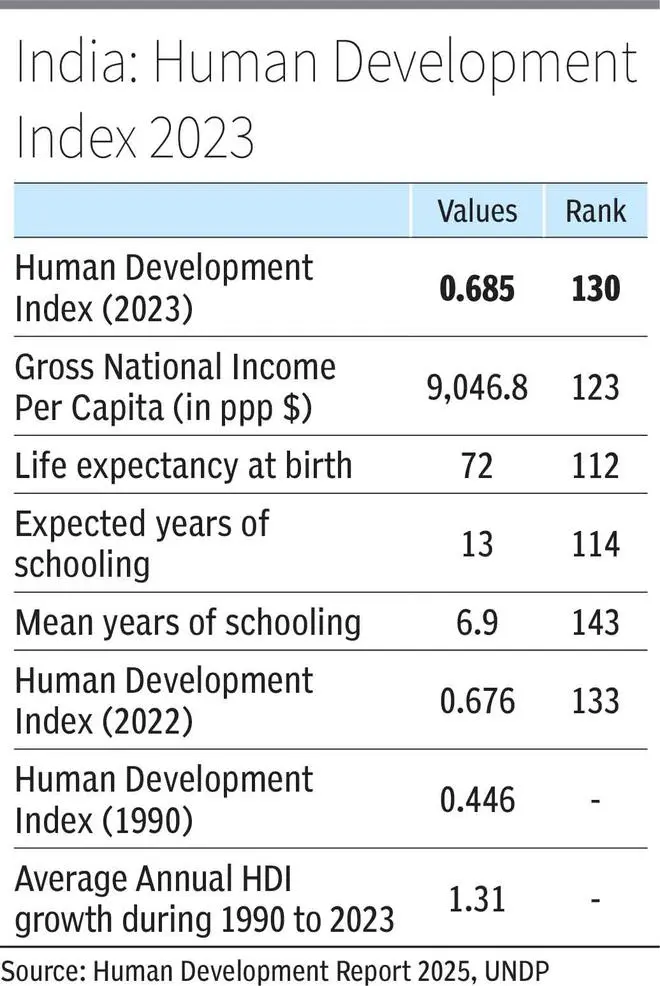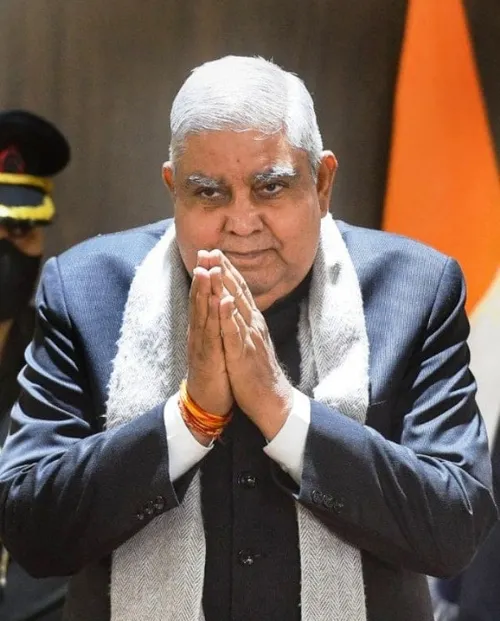
India’s Human Development Index rank would have been much higher if population had stabilised at the year 2000
| Photo Credit:
V RAJU
Recently, UNDP released Human Development Report 2025. According to the report, India moved up its Human Development Index (HDI) ranking from 133 in 2022 to 130 in 2023 out of 193 countries. The HDI value improved from 0.676 in 2022 to 0.685 in 2023. The gross national income per capita is one of the components of HDI. In this context we discuss here two issues: (1) Progress of HDI over time; (2) Role of per capita income in the performance of India’s HDI.
We look at the progress of HDI over the period 1990 to 2023. India’s HDI value has increased from 0.446 in 1990 to 0.685 in 2023 – an increase of 53 per cent in 33 years with the growth of 1.31 per cent per annum (see Table). HDI for India is moving faster than both the global and South Asian averages.

During the same period: (a) the gross national per capita rose from $2,167 to $9,048 — increasing four times; (b) life expectancy rose from 58.6 years to 72 years — an increase of 23 per cent; (c) the expected years of schooling rose from 8.2 years to 13 years. These are significant achievements in the post-reform era. However, India lags behind many countries in HDI rank. Other BRICS countries Russia (64), China (75), Brazil (84) South Africa and some other Asian countries like Sri Lanka (78) Indonesia (113) and the Philippines (117) rank above India, while Bangladesh (130) has similar rank. In the South Asian region, only countries like Nepal (145), Myanmar (149) and Pakistan (168) have lower ranks in HDI than India.
Per capita income
The Human Development Report says that India is in the medium human development category with an HDI value of 0.685 in 2023 and moving closer to the high human development threshold of 0.700. However, it takes much longer time for India to catch up with many BRICS and Asian countries as per capita income is lower partly due to the demographic pressures.
It may be noted that HDI is a summary measure of average achievement in key dimensions of human development: health, education and standard of living. The health dimension is assessed by life expectancy at birth, the education dimension is measured by mean of years of schooling for adults aged 25 years and more and expected years of schooling for children of school entering age. The standard of living dimension is measured by gross national income per capita.
It may be noted that one can analyse the progress of non-income indicators like education, health, income or consumption over time. But, converting all of them into an index poses several aggregation problems. In principle, they should be independent.
TN Srinivasan (2007) pointed out that “collapsing many relevant but not necessarily commensurate dimensions into a single index defined as an arbitrarily weighted sum of disparate indexes makes little sense. The Human Development Index pioneered by the United Nations Development Programme is an example of an arbitrarily weighted sum of non-commensurate indexes. It certainly is not a multidimensional conceptualisation in any meaningful sense but simply yet another arbitrary unidimensional index”.
Turning to HDI, the three components have equal weights. The GNI per capita income has one-third weight in the index. India is the 4th or 5th largest economy in the world in terms of the level of GDP and its GDP is growing at 6-7 per cent which is the highest among the large economies. However, per capita income at $9,047 (in ppp) is still very low compared to many other countries.
The Table provides the ranks of the components of the HDI. The rank of per capita GDP (in ppp) in India is 123 while those of life expectancy and expected years of schooling respectively are 112 and 114. In other words, the rank of per capita income is much lower than the health component and one of the indicators of education. In the case of mean years of schooling, another indicator of education, India’s rank is much lower at 143.
Per capita income in India is lower due to higher population. If India’s population had remained stable at, let us say, 2000 level, the GNI per capita income in India for the year 2025 would have been $12,282 (in ppp) with a rank of 114. In other words, HDI rank would have been much higher if population had stabilised at the year 2000. Thus, the low per capita income in India is partly due to the high population numbers which may stabilise only after 2050. Therefore, the low level of per capita GDP in India may limit significant progress in HDI income.
HDI was evolved because income did not indicate clearly human development. But the way income has entered into the calculation makes it not very different from the ranking that a country will get purely on the basis of income. An analysis done shows that the rank correlation co-efficient between the real GDP per capita Index and the Human Development Index for all 193 countries is high at 0.97. However, taking only Medium Human Development countries, it is seen that the rank correlation co-efficient with GDP Index is lower at 0.78.
There are two conclusions from our analysis. First one is that the ranking according to the per capita income and the HDI ranking are very close. In India’s case, the low HDI ranking is partly due to high population. Our rank in the HDI will continue to be low with population continuing to grow. This only shows the distance we must travel on income which is an important component of HDI. We have no choice but to grow fast given the present level of per capita income.
Rangarajan is former Chairman, Economic Advisory Council to the Prime Minister, and former Governor, RBI; Dev is former Chairman, Commission for Agricultural Costs and Prices, and former Vice Chancellor, IGIDR, Mumbai
Published on June 7, 2025
Anurag Dhole is a seasoned journalist and content writer with a passion for delivering timely, accurate, and engaging stories. With over 8 years of experience in digital media, she covers a wide range of topics—from breaking news and politics to business insights and cultural trends. Jane's writing style blends clarity with depth, aiming to inform and inspire readers in a fast-paced media landscape. When she’s not chasing stories, she’s likely reading investigative features or exploring local cafés for her next writing spot.





